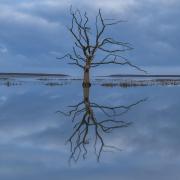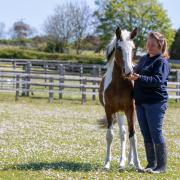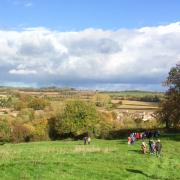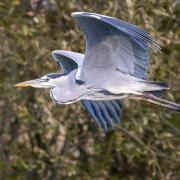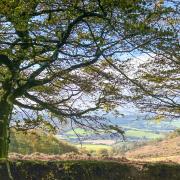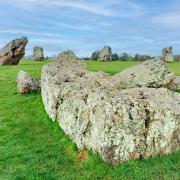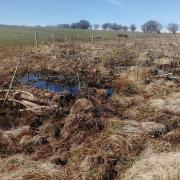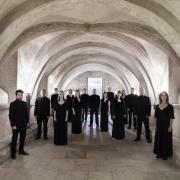Scupltor and painter Maggie King talks to Clare Bourke about how Somerset inspires and influences her work

In a busy world, it’s important to find time to just sit and be yourself. And that’s certainly what artist Maggie King seems keen to inspire with her sculptures, all with the central theme of calm.
“When you look at nothing, you are faced with what’s going on inside you. When’s it’s busy around you it doesn’t give you the chance to focus on yourself and contemplate,” explains Maggie.
A sculptor in stone and wood, Maggie has lived in Somerset for 13 years, moving down from Surrey in 2003 to be closer to her sister.
“I had two grown up daughters and then when I got divorced I stayed living in Surrey but I started to find it quite claustrophobic. I wanted to go somewhere my eye could travel a bit further. I found this little cottage in Minehead and it just says a lot about why I love Somerset. It’s on a hillside so I can see look out of the front window and see the church and look the other way and see the sea.”
Indeed, Somerset has become a huge influence on Maggie’s work, becoming the inspiration for the central themes of her work.
“I love that feeling that the land is tumbling into the sea. When you drive up through Porlock and onto the coast road you get the wonderful view across the moor, this rolling farmland and then the sea. You get the feeling of people working on the land and working on the sea. I have a big work ethic – my work is about carving from stone and this is a working place.”
One of the main Somerset inspirations for Maggie are boats, which have always been a central theme to her work.“I love being on them and looking at them. I use the boat shape quite a lot as it’s an image of safety for me. I see them as safe nests that float on the water. It’s reflected in my work. The whole thing about the sea is the boat is like a little safe container that protects you. If in your life you have been damaged there’s always a sense of wanting that protection. You could be damaged but a boat is a safe place.
“The other thing I love is all the little chapels and churches in the area such as St Peter’s on the quay in Minehead and the Culbone Church, which is amazing and gives a wonderful sense of serenity and spirituality. I also love Cleeve Abbey. There again you have got a place that’s quite unique and the buildings have been very well preserved. I find that quite inspirational.”

So did moving to Somerset change her style of work?
“No, not at all but what Somerset has given me is it has compounded what I was doing. There were things in my head I was interested in but couldn’t see, such as boats. Here I can actually see the boats, just down the road. Moving here hasn’t changed my work but things that are closest to my heart are here.
“My spiritual life has always been important to me. Being in a place that has all the imagery I find inspirational – sea, boats, churches.”
Maggie, 71, shares a studio in two old coach houses in Nettlecombe with fiancé Matthew Ensor, also an artist, and the couple have lived together at their home in North Hill, Minehead, for eight years.
“Matthew’s style is very different to mine,” explains Maggie. “His work is quite surreal and I’m fascinated by what he does. He gains inspiration from things he collects at car boot sales and junk shops and uses a lot of collage, as well as being a sculptor and painter. He is giving people a lot to think about, he gives people a lot of depth.
“The base of my work is a balanced image and a clean image. I get my inspiration from my heart and my soul.”
Maggie has been a Quaker for some years and when the two get married next spring it will be a Quaker wedding at The Tythe Barn in Dunster. Although Matthew is not a Quaker he is sympathetic to Maggie’s beliefs.
“There’s a lot about my work that’s related to the Quaker way of life,” says Maggie. “When we have our meetings it’s about sitting quietly and waiting for what might come to you out of your heart or your head and you can say what you feel if you think it will be of use to people in the circle with you. It’s a beautiful thing and I hope my work gives people this calm image and ability to find that in themselves.”

Maggie came to art later on in her life after her daughters – Elizabeth, now 47, and Alison, now 45 - were in their teens.
“I was a secretary until I married and then I had children and stopped work. When they were teenagers I then started to go to adult education classes and started making clay models and my tutor told me I was doing very well. I thoroughly enjoyed it. Another class had stone and I wanted to try it so I got a mallet and chisel and started and found I couldn’t stop. I loved it.
“But then I got a repetitive strain injury so I had to stop that and joined a school of art a couple of days a week.”
After studying at the Sir John Cass School of Art in London, Maggie started teaching carving but decided she needed more tuition so completed a degree at West Surrey College of Art & Design. It was around this time in her life that she got divorced, a move which she believes led to her central theme of calm and silence in her work.
She explains: “I started to find silence very important. My husband left and the children were grown and left home and I found the silence frightening at first but it became something meaningful.”
As well as exhibiting in London and Surrey, Maggie has exhibited at a number of local galleries, most notably at The Court Gallery in West Quantoxhead, where some of her most recent work is on display.
She is now experimenting with some new ideas and is currently gaining her influence from African masks and Aboriginal sculpture, looking at their earthy quality and experimenting with wrapping objects in string. “I am just investigating it at the moment. When you wrap something it’s like taking care of it.”




